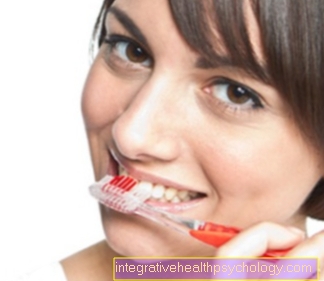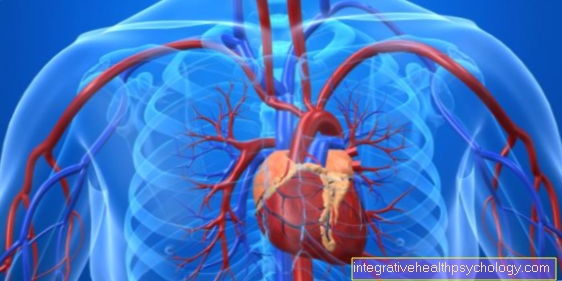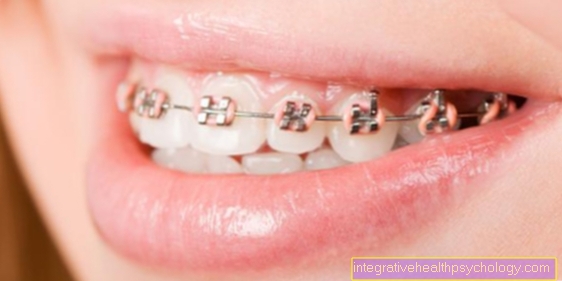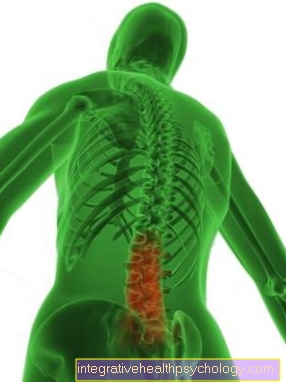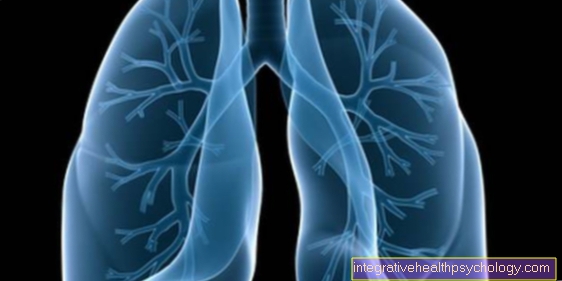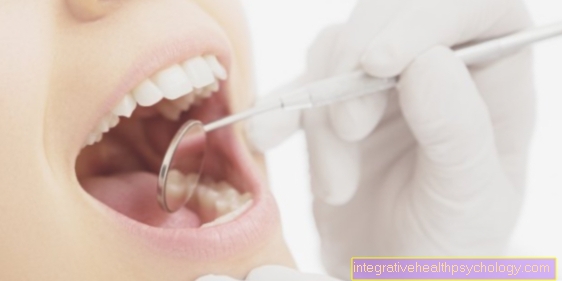Plaque
introduction
The dental plaque known as plaque is a soft bio-film which forms on the surface of the tooth after eating and which can be removed with a toothbrush.
Dental plaque is a substance that is composed of various components. It contains various proteins, carbohydrates and phosphate compounds. In addition, a large number of microorganisms can be detected when analyzing the deposits.
Plaque that remains on the tooth surface over a long period of time and is not removed or only insufficiently removed can lead to various diseases:
On the one hand, the deposits can lead to inflammatory processes in the area of the gums (inflammation of the gums / gingiva) after they sink below the gumline. On the other hand, plaque that adheres to the tooth surface or in the interdental spaces can promote the development of carious defects.

How is plaque created?
The formation of plaque takes place over several steps.
Initially, it forms on the tooth surface from saliva protein and the smallest cell remains of the oral mucosa existing precipitation. In dental jargon, this protein substance is called a pellicle.
The process of forming this plaque component takes about an hour. At this point, the thin film that adheres to the tooth surface can still be removed very easily by rinsing with clear water.
Over time, bacteria begin to settle on the protein layer. The most important bacterium for the formation of plaque, Streptococcus mutans, is not part of the normal oral flora and is responsible for the formation of a substance called dextran. Dextran is a derivative of sugar that serves as a bacterial reserve.
On the basis of these bacteria, further pathogens can settle, multiply and secrete dangerous metabolic end products over time.
With the help of these metabolic products, the bacteria and other microorganisms can supply each other with everything they need to survive. There is a kind of infrastructure between the microorganisms - they can communicate with each other and are partially dependent on each other.
At this point the plaque can no longer be removed by simply rinsing it off, the toothbrush must be used to remove the plaque.
Causes of Plaque
Plaque is dental plaque that has been colonized by bacteria. Fortunately, plaque deposits can still be removed by brushing your teeth. Poor oral hygiene promotes the development of plaque, but it also arises again immediately after cleaning and cannot be suppressed. However, it is important to brush your teeth at least twice a day in order to keep the To prevent the conversion of the removable plaque into the tartar that can no longer be removed independently.
A variety of different bacteria and microorganisms are present in the oral cavity. These settle on surfaces and attach themselves there. They are easiest to stick to rough surfaces, for example the edge of the gums, which is often poorly cleaned, or in between small indentations or fissures.
You can influence the colonization of the plaque a little by considering the following risk factors: A diet rich in sugar offers the bacteria the best nutrients and thus promotes their growth, and consequently also the growth of the plaque.
If you have a dry mouth and too little saliva, leftover food is not washed away, so that the bacteria can feed on the leftover food. Some medications also promote dry mouth. Other drugs, such as some sleeping pills or blood pressure regulators, encourage bacteria to grow. The bacterial flora in the mouth is also disturbed by stress, lack of sleep and, above all, by smoking and alcohol abuse.
Risks of plaque
The (unchanged) Microorganisms can damaging influence exert on the tooth structure and gums.
With frequent and / or high sugar consumption, the growth of these microorganisms is increasingly promoted, since under these circumstances there is an oversupply of nutrients for bacterial pathogens within the oral cavity.
The colonization of the tooth surface leads to the formation of acids, which are a metabolic product of the bacteria. They can loosen the tooth substance and thus cause the smallest lesions.As a result, artificial dirt niches are created in which germs can settle particularly well.
If the plaque is not removed regularly and properly, the development of carious defects can no longer be averted. In addition, over time, the deposits can continue to below the gumline and lead to the formation of deep gum pockets there.
Bacteria and other microorganisms find an ideal living space in these pockets, can multiply and permanently damage the gums by secreting their metabolic end products. Inflammation in the gum area is often the result.
If the appropriate treatment is neglected, these inflammatory processes can also spread to other structures of the tooth supporting apparatus (for example the jawbone) and cause periodontitis (Inflammation of the tooth bed) trigger. In many cases this leads to the regression of the gums and / or irreversible bone loss. In the worst case, the affected patient loses teeth that are actually perfectly healthy.
Concomitant symptoms
Plaque that is not removed regularly has ever more fatal consequences. Over time, the plaque turns into tartar, as the minerals in the saliva are deposited in it. The bacteria lead to tooth decay and inflammation.
Colorings in food give it a yellow-brown discoloration. Especially after eating sugary food, the caries bacteria produce acid in the plaque, which can then act directly on the tooth. This demineralizes the tooth and creates caries.
Other bacteria, which act through a different mechanism of action, migrate under the gums and lead to gingivitis. If this is not treated, gingivitis is followed by periodontitis, i.e. an inflammation of the entire periodontium. The result is tooth loss. If there is inflammation in the mouth area, there is also bad breath.
Plaque vs. Tartar
Plaque is a biofilm made up of food residues, saliva, bacteria and their metabolic products. This sticky film keeps building up despite brushing your teeth. After 4 to 12 hours at the latest, he has trained again.
However, tartar only arises where there is dental plaque, because it arises directly from the plaque. This reacts with minerals from the saliva and turns to stone into hard tartar that can no longer be cleaned away.
Depending on the composition of the saliva, tartar develops faster in some patients than in others. However, if you have good oral hygiene and regularly remove plaque thoroughly, you will not get tartar.
Tartar is most likely to be found at the exit of the large salivary glands because the plaque there reacts directly with the minerals from the saliva. The ducts are located in the upper jaw on the cheek side in the area of the 1st and 2nd large molars. In the lower jaw it lies under the tongue. Because of this, there is often a lot of tartar on the inside of the lower incisors.
The advantage, insofar as one can speak of this expression, of tartar, is that where there is tartar, no living bacteria adhere to the tooth and can further damage it through tooth decay. You no longer receive oxygen and can therefore no longer produce tooth decay. However, the tartar is dangerous for the teeth holding apparatus. The bacteria migrate along the tooth into the gum pocket and lead via gingivitis to periodontitis, i.e. to inflammation of the gums and ultimately the entire periodontium. This results in early tooth loss.
Remove plaque at home
Plaque deposits should best be thoroughly removed from the tooth surface two to three times a day. In addition to the frequency, the quality of the tooth cleaning also plays a decisive role. It is important that the plaque can only be removed mechanically, i.e. by brushing, which shows the importance of brushing your teeth.
Coarse deposits can easily be removed with a toothbrush and a little toothpaste.
For patients with healthy gums, toothbrushes with medium bristles are particularly suitable. When choosing a suitable toothpaste, care should be taken to choose a product with the lowest possible abrasive content.
Coarse abrasive particles can roughen the tooth substance and in this way create artificial dirt niches on which bacteria and other microorganisms can settle particularly easily. In addition to cleaning the tooth surface, the care of the interdental spaces (Interdental spaces) great importance is attached to.
Especially in people with misaligned teeth or damaged gums, plaque build-up occurs in these areas. For this reason, the spaces between the teeth should be cleaned at least once a day with the help of so-called interdental brushes. Using dental floss is also usually enough to remove most of the plaque from between the teeth.
In order to reduce the speed of plaque formation, various antibacterial mouth rinses can be used after brushing your teeth.
Read more on the topic: This is how you can remove plaque
Remove plaque in the dental office

Despite their best efforts, some patients are unable to completely remove all plaque from the tooth surface.
Especially with misaligned teeth, very wide interdental spaces or pathologically changed Gums Daily oral hygiene can become difficult. Regular appointments at a dental practice can help these patients prevent the effects of dental plaque.
Most dental practices offer special prophylaxis sessions for this purpose. This prophylaxis session can either be done by the dentist himself or by trained professionals (Prophylaxis assistant; Dental assistant; ZMF; Dental hygienist; DH). The first step in such a session is to stain the tooth surface to reveal any plaque that has remained on the tooth surface.
This is followed by instructions on a targeted toothbrushing technique tailored to the respective patient. This is followed by a so-called professional tooth cleaning.
The attending dentist or dental assistant cleans all tooth surfaces with the help of a rotating cleaning device. So-called curettes are used immediately afterwards.
These devices are hand-held instruments that are sharpened at a specific angle and can be sterilized, with the aid of which food residues and dental plaque that sit in the area of the gumline can be completely removed. In addition, plaque (tartar) that sits above and below the gumline can be removed relatively easily. The individual curettes differ in the individual cut of their ends, which enables a specific tooth surface to be optimally cleaned. Regularly performing such a professional teeth cleaning can help to prevent the effects of plaque in the long term and to keep both the tooth substance and the sensitive gums healthy for a long time.
Plaque staining tablets
There are tablets as well as liquids or gels that stain the plaque and thus show where it has not been cleaned properly. The tablets are simply chewed and distributed in the mouth. The liquids and gels can be applied to the teeth with a brush. Many dentists and dental hygienists use them to show the patient which areas he has neglected and where he needs to brush more precisely.
There are also coloring tablets or toothpastes for use at home. If you are unsure about your toothbrushing technique, you should occasionally use the means to independently check the cleaning result. All funds contain an indicator that stains the starch contained in the plaque. There are systems in which the plaque is displayed in one color. Others differentiate between fresh and old plaque by color. The most modern system, which is used in some dental practices, shows the plaque in color only in UV light. The plaque remains colorless in normal light.
Find out more at: How to make dental plaque visible
Home remedies for plaque
If the plaque is still fresh, it can be easily removed by brushing your teeth. Since the plaque builds up again anytime, it is important to brush your teeth at least twice a day. You should use toothpaste containing fluoride to reduce the risk of tooth decay. Antibacterial mouth rinses and mouth rinses can also be used, but should never replace brushing your teeth, as the plaque can only be removed mechanically.
Changing the toothbrush regularly reduces the number of bacteria in the mouth. The toothbrush should therefore be changed every 2 months. If the bristles are already sticking out, you should replace the zan brush more often and work with less pressure. The spaces between the teeth, which make up 1/3 of the tooth surface, can often not be cleaned sufficiently with a toothbrush. Therefore, one should use dental floss or interdental brushes once a day. Most bacteria sit on the tongue. The fewer there are, the fewer bacteria can colonize the plaque. For this reason, tongue cleaning is a good way to fight against plaque.
After eating, we also recommend drinking a glass of water to bring the pH value from the acidic to the neutral environment. Most bacteria can only live in an acidic environment.
Sugar-free chewing gum can also support oral hygiene. Those that contain xylitol bring the pH of the saliva to neutral values more quickly.
We strongly advise against using home remedies such as citric acid or baking powder and salt. Although they loosen the plaque, they also attack the tooth enamel so much that it is rougher than before. New plaque can adhere to this rough surface all the more easily. In addition, the enamel is rubbed off by abrasive agents. Since it does not grow back in the course of life, you break yourself more than you do against the plaque.
Homeopathy for plaque
Plaque can only be removed mechanically. Therefore, homeopathy alone cannot counteract bacterial growth.
In addition to healthy oral hygiene, antibiotic medicinal herbs and plants that at least slow down bacterial growth can help. Such are for example sage, chamomile, thyme. Umckaloabo for example, reduces the chance of bacteria attachment. ginseng can be supportive in everyday stress. Still other remedies help over the nicotine addiction, which indirectly improves oral hygiene.


